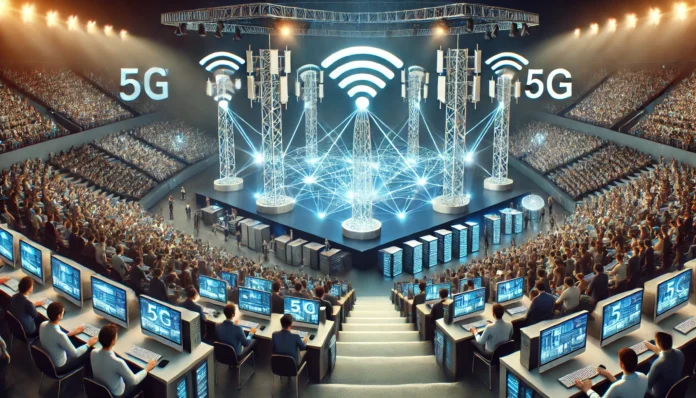Conducting huge events bear a strong demand for a network that is both trustworthy and scalable. With colossal crowds attending these events, numerous devices on the network, and high-bandwidth requirements, one must make sure connectivity does not stutter. This article discusses the best practices and necessary components for a successful network infrastructure for any major event.
Challenges for Network Infrastructure for Mega Events
High-Density Connectivity
Such events bring out thousands of people, with their connected devices in tow. This, therefore, creates a high-congested wireless network environment that gets slow in speed while drafting poor experiences.
Scalability and Flexibility
The design should bear the capability for size expansion to conform to specific needs at any variable demand period. Networks through an infrastructure that is not adapting to the peculiar needs of the growing demand almost invariably confront choke points and chaos.
Threats to Security
The Global Majors fascinate cybercriminals; lacking security measures sets up the whole network for cyberattacks ranging from DDoS attacks to data corruption and random breaches in the network.
Reliability and Redundancy
Any outage in the crucial network ruins event prospects, beginning from scanning parking tickets, water IDs to pumping functional live streams. There came a dire need of a strategy whereby network redundancy and fail-over mechanisms can maintain and keep connectivity afloat.

Primary Components of a Sound Network Infrastructure
1. High-throughput Wi-Fi and 5G Connectivity
Thus, high-density coverage is also provided by deploying high-durability Wi-Fi with buffering APs. Merging in 5G is able to provide lightning-speed connectivity and negligible latency for the attendees and organizers of the megavent.
2. Network Load Balancing
Technologies for the purpose of balancing loads ensure that traffic is evenly spread evenly across _networking resources while preventing congestion, thereby supporting the network fully.
3. Edge Computing for Low Latency
Edge computing allows one to lessen latency and optimize performance by execution of computation close to the users, which is greatly beneficial under a live-streaming scenario and potentially to various PCM applications.
4. Cybersecurity Measures
Firewalls, encryption protocols, and intrusion detection systems indeed represent an ideal trio of fundamental cybersecurity components for network security. Other alternative techniques can be implemented for networking technologies, such as network segmentation, to create a highly secure boundary for more vulnerable network operations.
5. Cloud-Based Network Management
Network management over the cloud permits remote network performance overviews and changes through the web interface. This portrays the network picture in real-time to allow organizers to fix any issues right away.
6. Redundant Power and Backup Systems
Being a life-extensive necessity, power stoppage destroys networks instantly. Protect your network against endpoints by deploying emergency-power systems with UPS and backup generators.

Best Practices for Deploying Event Networks
Site Survey
Conducting a full site survey preceding the event is highly critical to identify link-margin weak spots and potential sources of disturbance; it in turn provides an optimal solution to the placement of access points and other network gear.
Proper Capacity Planning and Peak Capacity
Those planning network capacities need to know the approximate number of guests and devices that they will connect so as to calculate bandwidth requirements accurately. Would it not always look far better to make sure you overprovision network capacity than skimp on usage?
Quality of Service (QoS) Implementation
The proceedings attached with the events require some kind of segregation to prefer one over the other; in this scenario, QoS should be implemented to cater to imminently essential activities like payment processing, ticket validation, and emergency calling through this project.
Temporary Network Infrastructure Deployment
Wherein it will not have the support of existing infrastructure, temporary network infrastructures using such mobile network solutions as these can be very useful in providing proper coverage-such as portable cell towers, satellite internet, or the mesh network.
Real-Time Monitoring and Optimization
Network monitoring tools will come in handy in monitoring event organizers to keep track of performance and find faults before having an impact on the users. This could also help with evaluations of possible network conditions and forecast issues so measures may be developed benefitting from it in real-time.

Conclusion
Networks used at major events should be planned with the precision with a focus on the events taking place in such an environment; as a result, seamless connectivity issues must be taken into account. Creating networks w replete with smart newborn technologies such as high-speed networks, things like edge computing, and a great deal of security in this new era of event Organizing would see towards a table, smoothen by a largeness, the digital involvement of participants. The protocol of AI-driven automation and lesser-known occurrences, like 6th generation networks, will improve network utilization for future events with further innovation in technologies.
Continue to stay connected at Jazz Cyber Shield for further insights and deeper knowledge about cybersecurity and tech domain.




Brilliant read! As someone who helps organize conferences, I know how critical stable connectivity is—but this blog laid it out in a way that really highlights the behind-the-scenes work. The section on temporary infrastructure and load balancing was especially insightful. Jazz Cyber Shield’s expertise in securing large-scale networks makes a huge difference at live events. Keep the quality content coming!